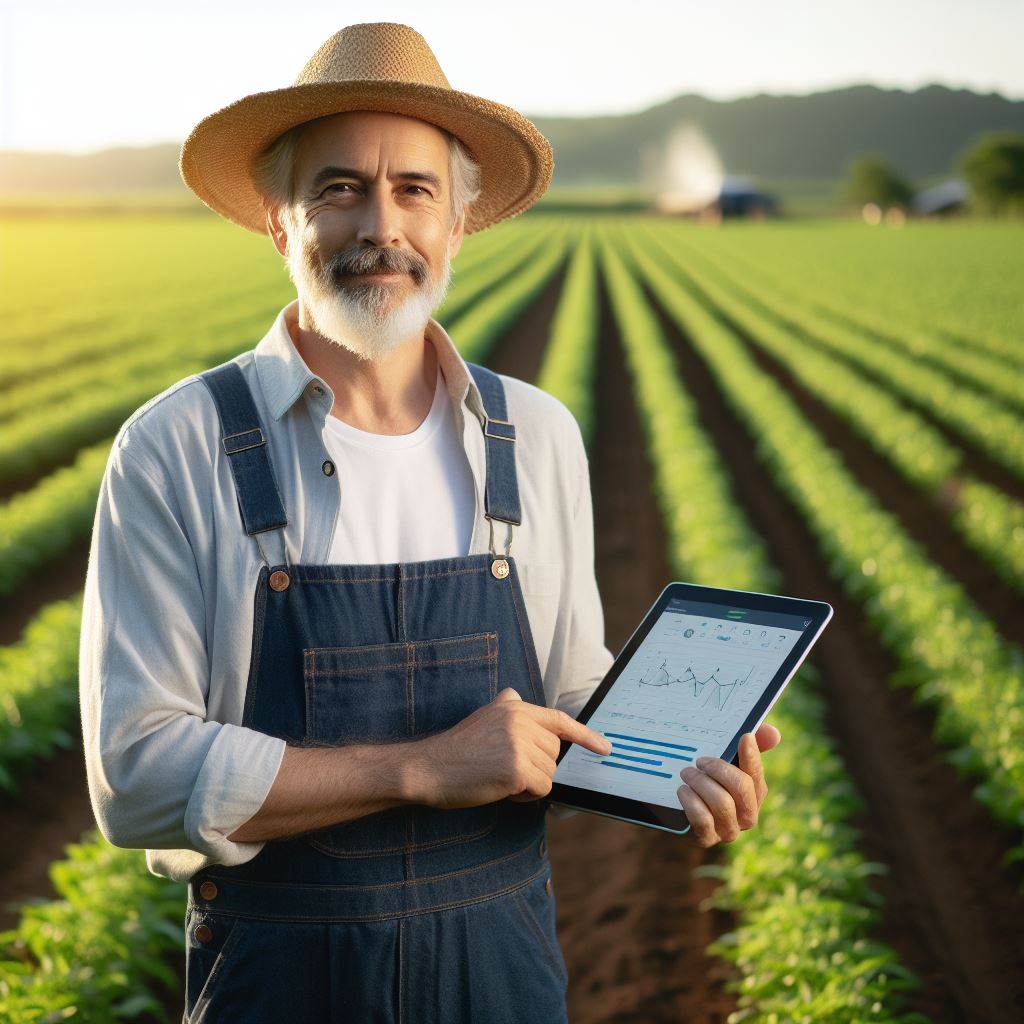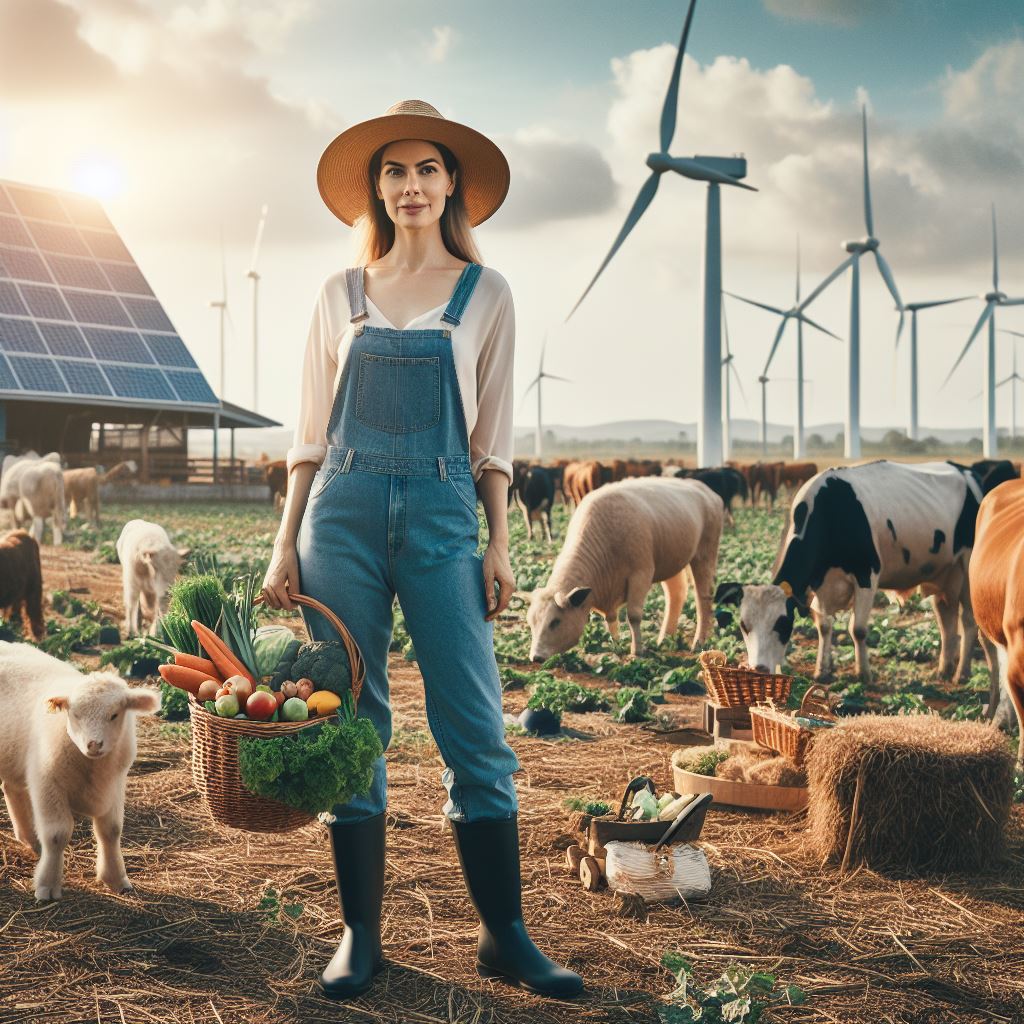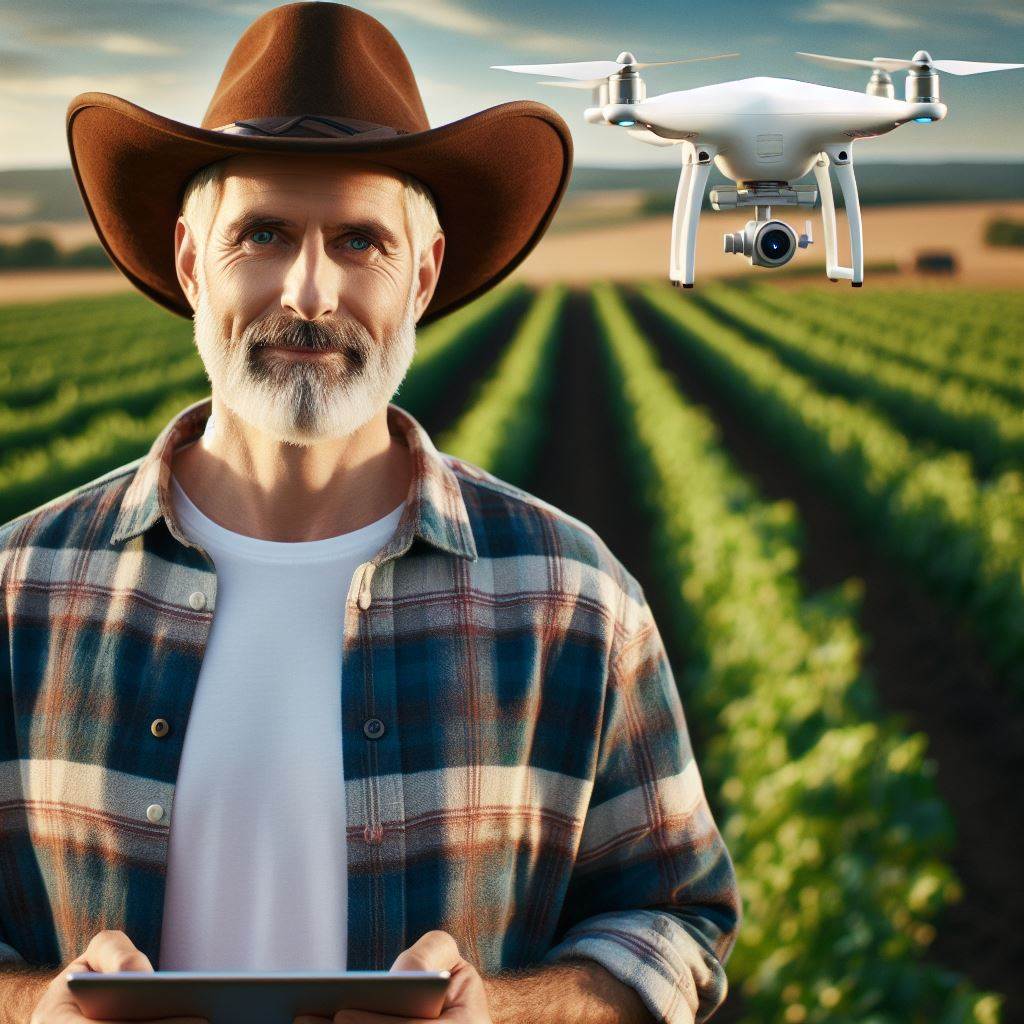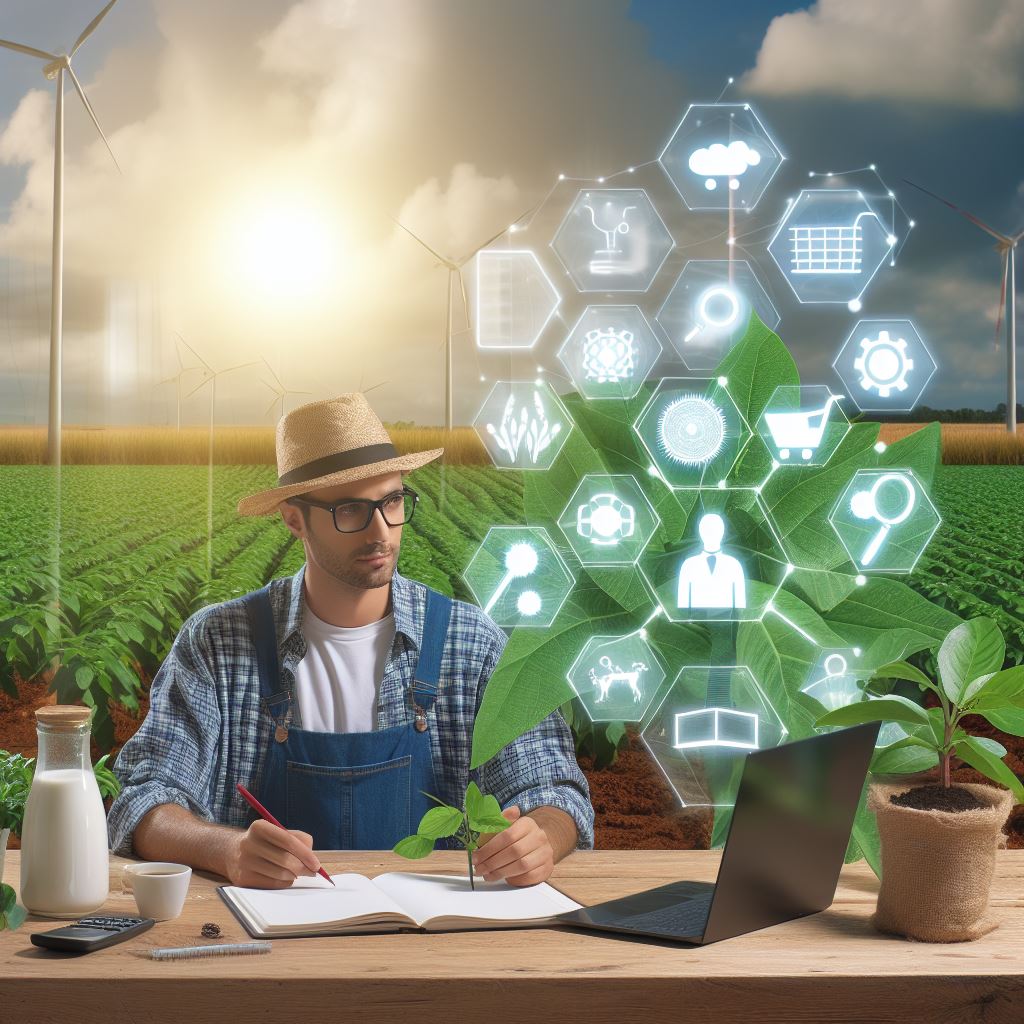Introduction
Precision agriculture is a cutting-edge farming approach that utilizes advanced technologies and data-driven decision-making to revolutionize farms.
This farming method aims to optimize resource usage and increase productivity while minimizing environmental impact.
Precision agriculture involves using techniques such as GPS mapping, remote sensing, and soil analysis to gather data on crop health, soil conditions, and weather patterns.
This data is then analyzed to identify specific areas of the farm that require attention, such as areas with nutrient deficiencies or pest problems.
By pinpointing these issues, farmers can apply fertilizers, pesticides, and irrigation only where and when needed, reducing wastage and potential environmental harm.
This targeted approach not only saves costs but also enhances crop yield and quality.
In addition to site-specific management, precision agriculture also utilizes automated machinery and robotics to perform tasks that were traditionally done manually, such as planting, harvesting, and spraying.
These technologies enable farmers to work more efficiently, reducing labor costs and increasing overall productivity.
Furthermore, precision agriculture allows farmers to monitor crops in real-time and make data-driven decisions.
This information helps them respond promptly to changing conditions, such as weather patterns or pest outbreaks, ensuring optimal crop growth and minimizing losses.
In summary, precision agriculture is revolutionizing farms by employing advanced technologies and data-driven decision-making.
This approach enhances resource efficiency, increases productivity, and reduces environmental impact.
By adopting precision agriculture, farmers can optimize their operations and contribute to sustainable and profitable agriculture.
The Benefits of Precision Agriculture
Precision agriculture, also known as smart farming, is revolutionizing the way farmers operate their farms.
By utilizing advanced technologies such as GPS, sensors, and data analysis, precision agriculture offers a wide range of benefits for farmers and the environment.
Transform Your Agribusiness
Unlock your farm's potential with expert advice tailored to your needs. Get actionable steps that drive real results.
Get StartedIncreased crop yield and quality
- Precision agriculture allows farmers to monitor and assess the conditions of their crops with great accuracy.
- By utilizing sensors and data analysis, farmers can identify specific areas that need attention, such as nutrient deficiencies or pest infestations.
- This targeted approach enables farmers to take immediate action, resulting in increased crop yield and enhanced quality.
Efficient use of resources (water, fertilizer, pesticides)
- Traditional farming methods often lead to the overuse of resources like water, fertilizers, and pesticides.
- Precision agriculture optimizes the application of these resources by providing precise information about the needs of each specific area.
- Farmers can apply water, fertilizers, and pesticides only where necessary, minimizing waste and reducing costs.
- This efficient use of resources also contributes to less pollution and a healthier environment.
Reduction of environmental impact
- Precision agriculture plays a vital role in reducing the environmental impact of farming practices.
- By using accurate monitoring and control systems, farmers can lower pollution caused by excessive use of chemicals.
- The precise application of fertilizers and pesticides reduces water contamination and protects nearby ecosystems.
- Overall, precision agriculture promotes sustainable farming practices, preserving the environment for future generations.
Cost savings for farmers
- Adopting precision agriculture can result in significant cost savings for farmers.
- By reducing resource wastage and optimizing inputs, farmers can cut down on expenses related to water, fertilizers, and pesticides.
- Precision agriculture also minimizes labor requirements as automated machinery and systems handle tasks efficiently.
- This cost-effective approach provides farmers with higher profits, enabling them to invest in advanced technologies and further improve their productivity.
In short, precision agriculture has brought about a multitude of benefits for farmers and the environment.
From increased crop yield and quality to efficient resource use and cost savings, smart farming techniques empower farmers to make data-driven decisions and optimize their operations.
Moreover, the reduction of environmental impact ensures sustainable farming practices and a healthier planet.
By embracing precision agriculture, farmers can embrace a more sustainable and profitable future.
Read: Moisture Sensors: Boosting Crop Yields
Key Technologies in Precision Agriculture
Global Positioning System (GPS) and Geographic Information System (GIS)
The integration of GPS and GIS technology has completely transformed precision agriculture.
GPS provides accurate positioning information for farmers, helping them monitor and control agricultural activities.
GIS combines GPS data with digital maps to provide farmers with valuable information about their land and crops.
Remote sensing and drones for data collection
Remote sensing technology allows farmers to collect crucial information about their crops without physical contact.
Using satellites or drones equipped with imaging sensors, farmers can monitor crop health, detect diseases, and predict yields.
This data helps farmers make informed decisions regarding irrigation, pest control, and crop management.
Precision implements and machinery
Precision implements and machinery have revolutionized how farmers plant, fertilize, and harvest their crops.
These advanced tools are equipped with sensors and software that allow precise and efficient farming operations.
Farmers can optimize inputs such as seed, water, and fertilizer, resulting in higher yields and reduced environmental impact.
Variable rate technology (VRT) for input application
VRT enables farmers to apply inputs, such as fertilizers and pesticides, at variable rates across their fields.
Using data from soil samples and sensor readings, VRT systems can adjust application rates in real-time.
This technology ensures that each area of the field receives the optimal amount of inputs, enhancing crop health and reducing costs.
Internet of Things (IoT) and sensors for real-time monitoring
- The IoT and sensor technologies allow farmers to monitor their fields and livestock in real-time.
- Sensors collect data on soil moisture, temperature, humidity, and animal health, among others.
- This data is transmitted wirelessly to farmers’ devices, providing them with valuable insights for timely decision-making.
These key technologies are at the forefront of the precision agriculture revolution, empowering farmers to make data-driven decisions.
By harnessing the power of GPS and GIS, farmers can accurately navigate their fields and optimize crop management strategies.
Remote sensing and drones provide farmers with valuable information about their crops, enabling early detection of issues and effective interventions.
Precision implements and machinery improve operational efficiency, resource utilization, and overall crop productivity.
Variable rate technology allows farmers to tailor input applications, maximizing yields while minimizing costs and environmental impact.
The IoT and sensor technologies enable real-time monitoring of fields and livestock, ensuring proactive management and timely interventions.
As these technologies continue to advance, the future of precision agriculture looks promising, offering sustainable and efficient farming practices.
Showcase Your Farming Business
Publish your professional farming services profile on our blog for a one-time fee of $200 and reach a dedicated audience of farmers and agribusiness owners.
Publish Your ProfileBy embracing precision agriculture, farmers can revolutionize their operations, adapt to changing environmental conditions, and meet the growing demand for food.
With these key technologies at their disposal, farmers can truly unlock the potential of their land and achieve greater productivity and profitability.
Read: Irrigation Apps: Tech at Your Fingertips
Data-Driven Decision-Making
In the era of precision agriculture, data collection and analysis have become the backbone of farm management.
The ability to collect and analyze vast amounts of farm data has revolutionized the decision-making process.
Collection and analysis of farm data
Farmers now have access to a wide range of technologies that allow them to collect data from various sources such as sensors, drones, and satellite imagery.
This data includes information about soil moisture levels, temperature, crop health, and nutrient content.
Once this data is collected, advanced analytics tools can help farmers make sense of it.
By analyzing patterns and trends, farmers can gain valuable insights regarding the performance of their crops and make informed decisions about resource allocation.
Predictive modeling for crop management
Precision agriculture relies heavily on predictive modeling to optimize crop management practices.
By using historical data and advanced algorithms, farmers can predict the likelihood of pest infestations, disease outbreaks, and crop yield fluctuations.
With this knowledge, farmers can take proactive measures to prevent crop loss, such as applying targeted treatments or adjusting planting densities.
Predictive modeling also enables farmers to optimize the timing of crop inputs, such as fertilization and irrigation, based on weather patterns and crop growth stages.
Smart irrigation and fertilization based on real-time data
Thanks to the availability of real-time data, precision agriculture has made significant advancements in optimizing irrigation and fertilization practices.
Sensors placed in the fields can provide continuous updates on soil moisture levels, enabling farmers to apply water precisely when and where it is needed.
Similarly, real-time data on nutrient levels can help farmers make accurate decisions about fertilizer application.
By applying fertilizers based on the specific needs of each area within a field, farmers can minimize waste and ensure that crops receive adequate nutrients for optimal growth.
Optimization of planting and harvesting schedules
- Data-driven decision-making also plays a crucial role in optimizing planting and harvesting schedules.
- By analyzing historical climate data and crop behavior, farmers can identify the optimal timeframes for planting different crops.
- Furthermore, real-time weather data can help farmers adjust their schedules to avoid unfavorable conditions that could negatively impact crop quality and yield.
- By using these insights, farmers can maximize productivity and achieve higher crop yields while minimizing the risk of losses due to extreme weather events.
In a nutshell, data-driven decision-making has revolutionized farm management practices in the realm of precision agriculture.
The ability to collect and analyze farm data has provided farmers with valuable insights, enabling them to optimize crop management practices, improve resource allocation, and maximize productivity.
With further advancements in technology and the integration of artificial intelligence, the future of precision agriculture looks even more promising.
Read: 2024’s Top Smart Irrigation Systems Reviewed
Challenges and Barriers
As precision agriculture becomes more prevalent in the farming industry, it is not without its share of challenges and barriers.
From initial investment costs to data management difficulties, farmers face several obstacles when adopting this technology.
Let’s take a closer look at some of the major challenges:
Initial Investment and Cost of Technology Adoption
- The adoption of precision agriculture requires a significant initial investment.
- Farmers need to purchase various high-tech tools and equipment to implement these practices.
- The cost of acquiring GPS systems, drones, sensors, and other precision agriculture technologies can be substantial.
- For many farmers, this financial burden poses a significant challenge and may deter them from adopting the technology.
Data Management and Integration Challenges
- Precision agriculture generates vast amounts of data from multiple sources, including machinery, sensors, and satellites.
- Managing and integrating these diverse data sets can be a daunting task for farmers.
- They need the right infrastructure and tools to collect, store, analyze, and make sense of this data.
- Data privacy and security also present concerns that must be adequately addressed.
- Without proper data management and integration, the potential of precision agriculture cannot be fully realized.
Infrastructure Requirements
- Precision agriculture heavily relies on technology, particularly internet access, to function effectively.
- Many rural areas still lack reliable and high-speed internet connectivity, limiting the adoption of precision agriculture.
- Adequate infrastructure is essential to enable seamless communication and data transfer between devices and systems.
- In areas with insufficient infrastructure, farmers face significant barriers to implementing and benefiting from precision agriculture.
Training and Education for Farmers
- The adoption of precision agriculture requires farmers to acquire new skills and knowledge.
- They need to learn how to operate complex technologies and interpret data generated by these tools.
- Training and education programs are necessary to enable farmers to effectively utilize precision agriculture tools and practices.
- Access to quality training can be a challenge, especially for small-scale or less technologically adept farmers.
- Support from agricultural institutions and government agencies is crucial in providing training opportunities for farmers.
Basically, while precision agriculture offers numerous benefits, there are several challenges that farmers must overcome.
The initial investment cost, data management complexities, infrastructure limitations, and the need for training and education all pose significant barriers.
However, with the right support and solutions, these challenges can be tackled, enabling more farmers to revolutionize their farms and embrace the potential of precision agriculture.
Read: Farming Data: AI’s Analytical Power

You Might Also Like: Biotech in Agriculture: A Modern Twist
Successful Case Studies
In this section, we will explore real-life examples of farms that have successfully implemented precision agriculture techniques and reaped significant benefits.
Example 1: Syverson Farms
Syverson Farms, a leading agricultural producer, managed to increase their crop yield by an impressive 20% through the adoption of precision agriculture techniques.
By utilizing advanced data analytics, they were able to fine-tune their planting strategies, fertilizer applications, and pest management practices, resulting in higher productivity and improved profitability.
Example 2: Reiter Family Farms
Reiter Family Farms, a renowned name in the agricultural industry, successfully reduced their water usage by an astounding 30% by implementing precision irrigation systems.
Through the use of sensors and real-time monitoring, they achieved unparalleled control over water distribution.
They optimized irrigation schedules and reduced wastage, all while maintaining optimal soil moisture levels for their crops.
Example 3: Farming Cooperative
- A farming cooperative, comprising several small-scale farmers, took a collective step towards precision agriculture and experienced significant cost savings.
- By leveraging precision technology, they optimized their input usage such as seeds, fertilizers, and pesticides, leading to reduced expenses without compromising on crop yield or quality.
- Additionally, they harnessed the power of remote sensing and satellite imagery to identify and rectify inefficiencies in their operations.
- This streamlined approach further contributed to their overall savings.
These case studies highlight the transformative power of precision agriculture in modern farming practices.
They demonstrate how embracing technological advancements can lead to remarkable improvements in crop yield, resource utilization, and cost-effectiveness.
With precision agriculture, farmers have the means to make data-driven decisions, increase productivity, and minimize environmental impact.
Furthermore, these success stories inspire other farmers, both small and large scale, to explore and adopt precision agriculture practices and techniques.
By sharing these real-life examples and their tangible benefits, the agriculture industry can collectively revolutionize farming practices worldwide.
Showcase Your Farming Business
Publish your professional farming services profile on our blog for a one-time fee of $200 and reach a dedicated audience of farmers and agribusiness owners.
Publish Your ProfilePrecision agriculture represents a game-changing approach that ensures sustenance for a growing global population while minimizing the ecological footprint of farming operations.
As technology continues to advance, it is crucial for farmers to stay up-to-date and actively seek ways to integrate precision agriculture into their own practices.
By doing so, they can join the ranks of Syverson Farms, Reiter Family Farms, and other successful adopters, and contribute to the ongoing revolution in modern agriculture.
Discover More: Innovative Water Conservation in Farming
Future Trends and Potentials
The future of precision agriculture is filled with exciting advancements and potentials that are set to revolutionize the farming industry.
Here are some key trends that we can expect to see:
Artificial Intelligence and Machine Learning in Precision Agriculture
Artificial Intelligence (AI) and Machine Learning (ML) technologies are increasingly being integrated into precision agriculture systems.
Farmers can use AI and ML algorithms to analyze vast amounts of data collected from sensors and satellites, allowing them to make data-driven decisions and optimize various farming practices.
For example, AI and ML tools can help farmers predict crop yields, analyze soil health, identify diseases or pests, and optimize irrigation and fertilization schedules.
By harnessing the power of AI and ML, farmers can improve efficiency, reduce costs, and minimize environmental impact.
Integration of Robotics and Automation
The use of robotics and automation systems is another trend that will shape the future of precision agriculture.
Robots can perform various tasks such as planting seeds, monitoring crop health, applying treatments, and harvesting crops.
These robots can be equipped with sensors, cameras, and robotic arms to navigate fields, detect weeds and pests, and perform precise operations.
By automating repetitive and labor-intensive tasks, farmers can save time, increase productivity, and enhance overall farm management.
Advancements in Data Analytics and Predictive Modeling
Data analytics and predictive modeling are crucial in precision agriculture as they provide valuable insights that help farmers make informed decisions.
Advances in data analytics technologies, such as cloud computing and edge computing, enable real-time processing of data collected from various sources.
By analyzing historical and real-time data, farmers can gain insights into crop performance, identify patterns and trends, and make data-driven predictions.
This allows them to adjust their farming practices and mitigate risks, ultimately leading to higher yields and better resource management.
Potential for Autonomous Farming Systems
- The future of precision agriculture holds immense potential for autonomous farming systems.
- These systems can operate without human intervention and perform tasks such as planting, monitoring, and harvesting crops.
- Autonomous farming systems rely on a combination of technologies, including robotics, AI, ML, and GPS.
- They can navigate fields, make real-time decisions, and adapt to changing environmental conditions.
- By embracing autonomous farming systems, farmers can increase efficiency, reduce labor costs, and tackle the challenges of labor shortages.
Ultimately, as precision agriculture continues to evolve, we can expect to witness the integration of artificial intelligence and machine learning, the use of robotics and automation, advancements in data analytics and predictive modeling, and the emergence of autonomous farming systems.
These trends hold great promise for transforming farms into highly optimized and sustainable operations, ensuring food security and environmental sustainability for generations to come.
You Might Also Like: Regenerative Agriculture: Tech Approaches
Conclusion
Precision agriculture plays a crucial role in revolutionizing farms by optimizing crop production, reducing costs, and minimizing environmental impact.
One of the key factors driving this revolution is the integration of technology and data-driven decision-making.
By utilizing sensors, drones, and other advanced technologies, farmers can collect precise data on soil conditions, crop health, and weather patterns.
This data enables them to make informed decisions regarding irrigation, fertilization, and pest control, leading to improved yields and resource management.
Precision agriculture also addresses the challenges faced by traditional farming, such as water scarcity, soil degradation, and labor shortages.
Through precision farming techniques, farmers can optimize water usage, reduce chemical inputs, and minimize soil erosion.
Furthermore, the adoption of automation and robotics can alleviate labor constraints and enable farms to operate more efficiently.
However, there are obstacles to overcome in implementing precision agriculture, including the initial investment costs and the need for specialized knowledge and skills.
Efforts should be made to provide education and training programs to farmers to enhance their understanding and utilization of precision agriculture tools.
In the future, precision agriculture holds promising prospects for revolutionizing farms by continuously advancing technology and data analytics.
With the integration of artificial intelligence and machine learning, farms will become even more efficient, sustainable, and productive.
By embracing precision agriculture, farmers can improve their profitability, protect the environment, and help meet the growing global demand for food.
The revolution is already underway, and through the combined efforts of farmers, researchers, and technology providers, the future of precision agriculture looks incredibly promising.




